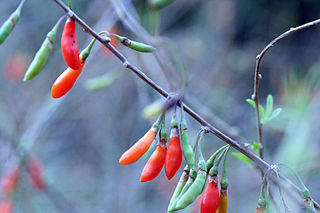
Herbal teas,also known as herbal infusions and less commonly called tisanes,are beverages made from the infusion or decoction of herbs,spices,or other plant material in hot water. Oftentimes herb tea,or the plain term tea,is used as a reference to all sorts of herbal teas. Many herbs are used in herbal medicine. Some herbal blends contain actual tea.

Prunus is a genus of trees and shrubs,which includes the fruits plums,cherries,peaches,nectarines,apricots,and almonds.

Secondary metabolites,also called specialised metabolites,toxins,secondary products,or natural products,are organic compounds produced by any lifeform,e.g. bacteria,fungi,animals,or plants,which are not directly involved in the normal growth,development,or reproduction of the organism. Instead,they generally mediate ecological interactions,which may produce a selective advantage for the organism by increasing its survivability or fecundity. Specific secondary metabolites are often restricted to a narrow set of species within a phylogenetic group. Secondary metabolites often play an important role in plant defense against herbivory and other interspecies defenses. Humans use secondary metabolites as medicines,flavourings,pigments,and recreational drugs.

Flavonoids are a class of polyphenolic secondary metabolites found in plants,and thus commonly consumed in the diets of humans.

Bearberries are three species of dwarf shrubs in the genus Arctostaphylos. Unlike the other species of Arctostaphylos,they are adapted to Arctic and Subarctic climates,and have a circumpolar distribution in northern North America,Asia and Europe.

Herbal medicine is the study of pharmacognosy and the use of medicinal plants,which are a basis of traditional medicine. With worldwide research into pharmacology,some herbal medicines have been translated into modern remedies,such as the anti-malarial group of drugs called artemisinin isolated from Artemisia annua,a herb that was known in Chinese medicine to treat fever. There is limited scientific evidence for the safety and efficacy of plants used in 21st century herbalism,which generally does not provide standards for purity or dosage. The scope of herbal medicine commonly includes fungal and bee products,as well as minerals,shells and certain animal parts. Herbal medicine is also called phytomedicine or phytotherapy.

Tetradium is a genus of trees in the family Rutaceae,occurring in temperate to tropical east Asia. In older books,the genus was often included in the related genus Euodia,but that genus is now restricted to tropical species. In cultivation in English-speaking countries,they are known as Euodia,Evodia,or Bee bee tree.

Phytochemicals are chemical compounds produced by plants,generally to help them resist fungi,bacteria and plant virus infections,and also consumption by insects and other animals. The name comes from Greek φυτόν (phyton) 'plant'. Some phytochemicals have been used as poisons and others as traditional medicine.

The açaípalm,Euterpe oleracea, is a species of palm tree (Arecaceae) cultivated for its fruit,hearts of palm,frons,and trunk wood. Global demand for the fruit has expanded rapidly in the 21st century,and the tree is cultivated for that purpose primarily.

Kanpō medicine,often known simply as Kanpō,is the study of traditional Chinese medicine in Japan following its introduction,beginning in the 7th century. It was adapted and modified to suit Japanese culture and traditions. Traditional Japanese medicine uses most of the Chinese methods,including acupuncture,moxibustion,traditional Chinese herbology,and traditional food therapy.

Cyclanthera pedata,known as caigua,is a herbaceous vine grown for its edible fruit,which is predominantly used as a vegetable. It is known from cultivation only,and its use goes back many centuries as evidenced by ancient phytomorphic ceramics from Peru depicting the fruits.

Passiflora incarnata,commonly known as maypop,purple passionflower,true passionflower,wild apricot,and wild passion vine,is a fast-growing perennial vine with climbing or trailing stems. A member of the passionflower genus Passiflora,the maypop has large,intricate flowers with prominent styles and stamens. One of the hardiest species of passionflower,it is both found as a wildflower in the southern United States and in cultivation for its fruit and striking bluish purple blooms. Passiflora incarnata fruit contain many seeds,each surrounded by an aril holding edible juice,and this juice can be consumed fresh or used to flavor processed products.

Phyllanthus emblica,also known as emblic,emblic myrobalan,myrobalan,Indian gooseberry,Malacca tree,or amla,from the Sanskrit आमलकी(āmalakī),is a deciduous tree of the family Phyllanthaceae. Its native range is tropical and southern Asia.

Lycium chinense is one of two species of boxthorn shrub in the family Solanaceae. Along with Lycium barbarum,it produces the goji berry ("wolfberry"). Two varieties are recognized,L. chinense var. chinense and L. chinense var. potaninii. It is also known as Chinese boxthorn,Chinese matrimony-vine,Chinese teaplant,Chinese wolfberry,wolfberry,and Chinese desert-thorn.

Phellodendron amurense is a species of tree in the family Rutaceae,commonly called the Amur cork tree. It is a major source of huáng bò,one of the 50 fundamental herbs used in traditional Chinese medicine. The Ainu people used this plant,called shikerebe-ni,as a painkiller. It is known as hwangbyeok in Korean and (キハダ) kihada in Japanese.

Petasites japonicus,also known as butterbur,giant butterbur,great butterbur and sweet-coltsfoot,is an herbaceous perennial plant in the family Asteraceae. It is native to China,Japan,Korea and Sakhalin and introduced in Europe and North America. It was introduced to southern British Columbia in Canada by Japanese migrants.

Dacryodes edulis is a fruit tree native to Africa,sometimes called safou,plum (Cameroon),atanga,ube (Nigeria),African pear,bush pear,African plum,nsafu,bush butter tree,or butterfruit.

Styphnolobium japonicum,the Japanese pagoda tree is a species of tree in the subfamily Faboideae of the pea family Fabaceae.

Angelica acutiloba is a perennial herb from the family Apiaceae or Umbelliferous. It is predominately in Japan and perhaps endemic (unique). It is now distributed widely and cultivated in Jilin,China,Korea,Taiwan and Indonesia.
Alisma orientale,commonly known as Asian water plantain,is a flowering plant species in the genus Alisma found in Asia.



















